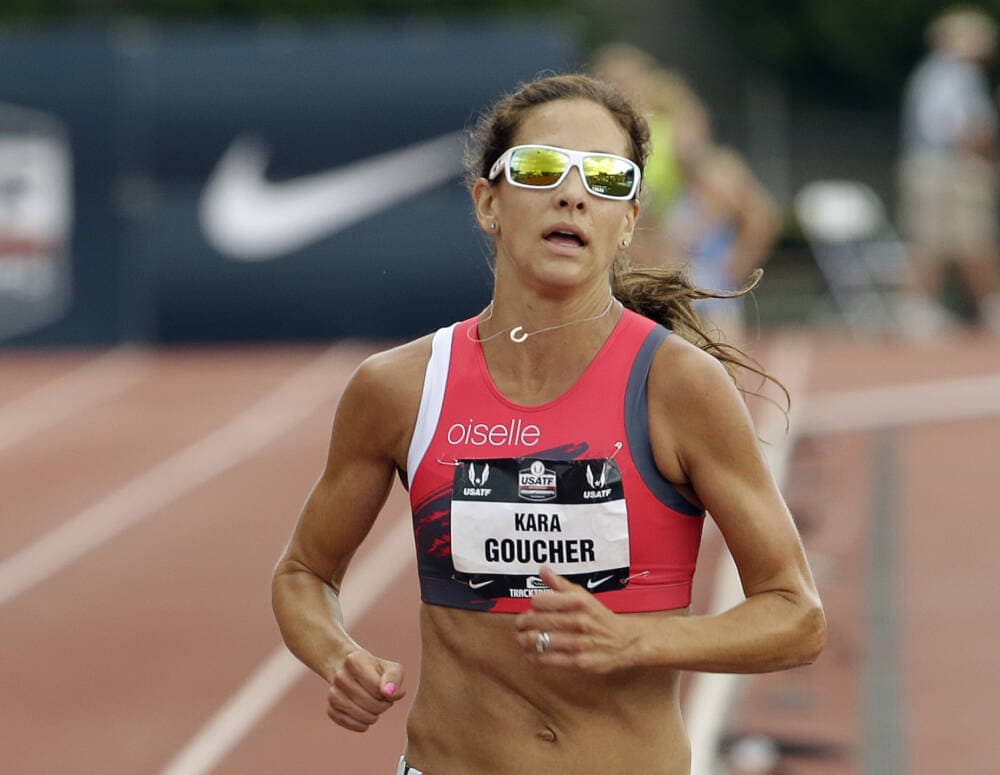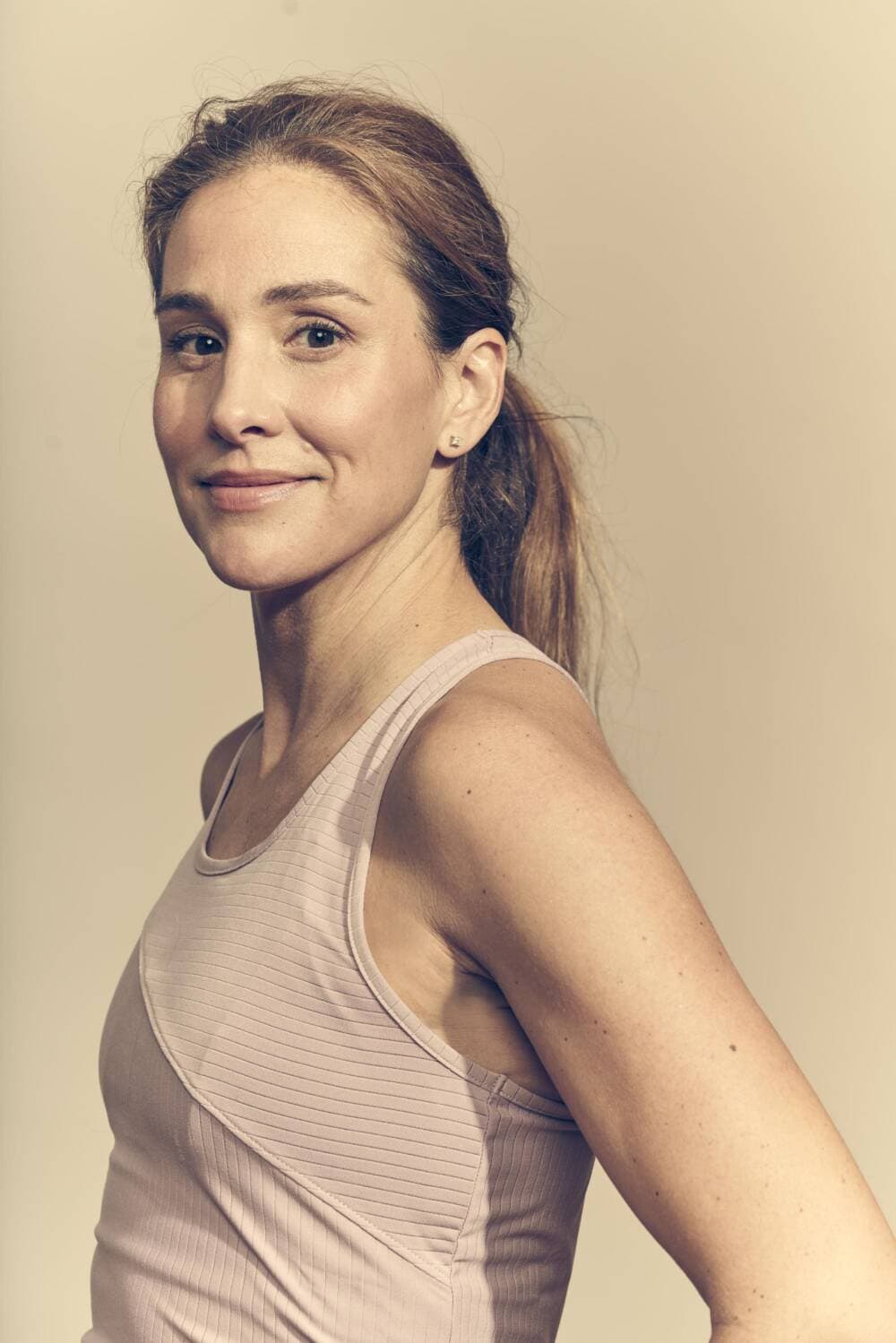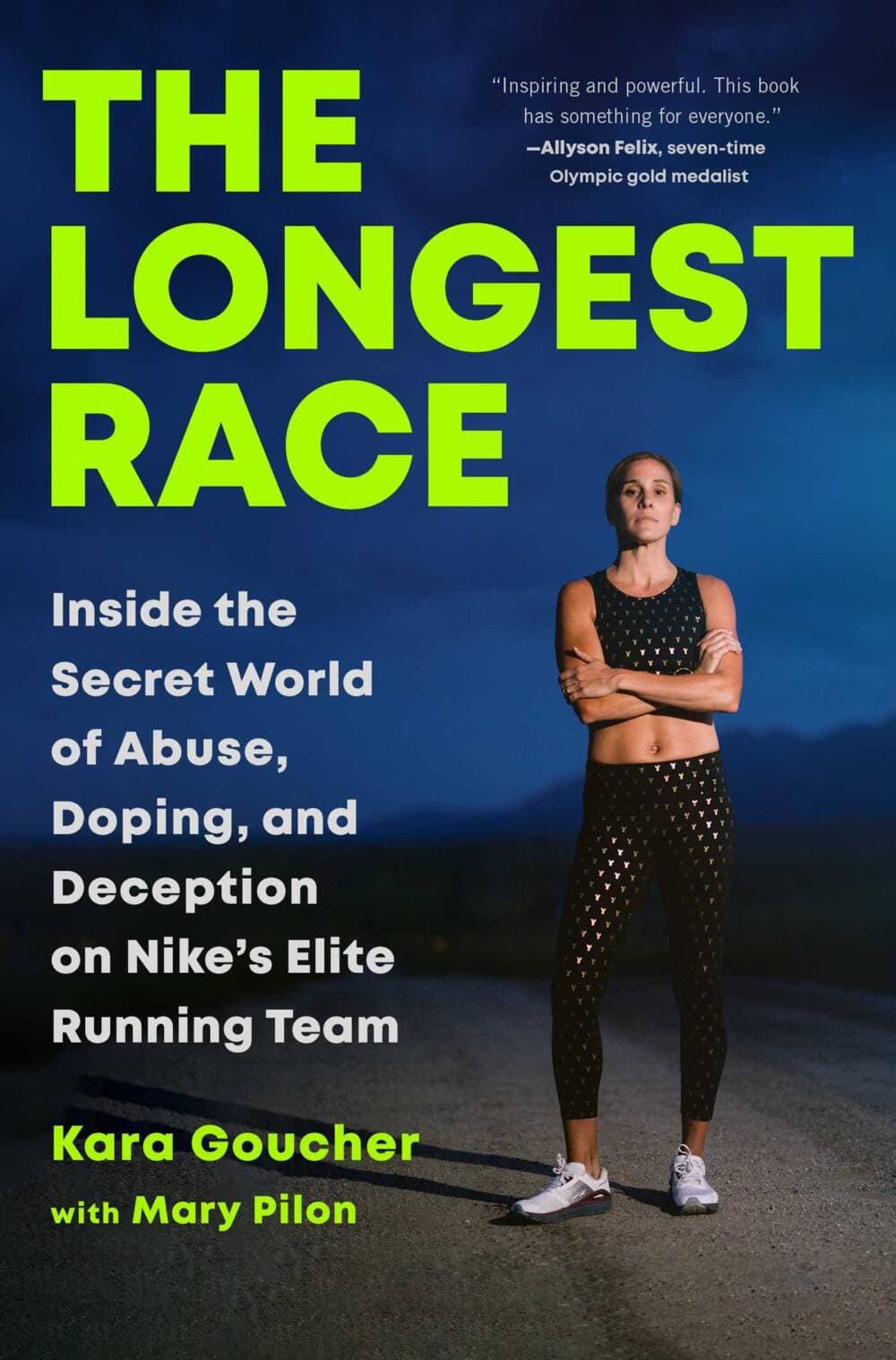Advertisement
Runner Kara Goucher blew the whistle on abuses, misogyny, and doping to spare others

Until recently there were two Kara Gouchers — the fit, powerful one the world saw, the first woman runner to join Nike's prestigious Oregon Project, coached by the storied Alberto Salazar. She was the young runner who burned up the college circuit, whose 2008 New York Marathon finish put an American woman on the podium for the first time in nearly 15 years, a silver medalist at the Osaka World Championships and more.
But the Goucher no one saw was tormented by a coach who said she was too fat, who commented on her breasts, and who told her she wasn't good enough. He also sexually assaulted her. Her new memoir "The Longest Race" tells the story of her evolution as a runner and as the whistleblower who eventually testified formally about doping in the Oregon Project — as she stayed clean — and about the abuse Salazar still denies. She joins Robin Young to talk about the journey.
Find the full conversation here.

Book excerpt: 'The Longest Race'
By Kara Goucher
In May 2005, Alberto took me, Adam, and Galen to Park City, Utah, for our first Nike Oregon Project high-altitude training camp. We all shared a condo, which emphasized the familial feelings. (Other runners like Mike Donnelly, Dave Davis, and Dan Browne were part of the team but more intermittently so—some worked full-time jobs in addition to running, others were injured, others came and went—while Adam, Galen, and I became the consistent, core group.) I was healed from my surgery and working out again, and the idea was to put in miles at altitude in a focused, retreat-like atmosphere.
After altitude camp, my fitness improved and my results picked up. I joined Adam, Galen, and Alberto in Europe for races in the summer—my first trip abroad with the Oregon Project. It was both an exciting moment, and a time of confronting some harsh realities. At a competition in Li- gnano, Italy, I was posing for a photo with the meet director and he let his hand slip to rest on my breast as the picture was taken. I told the guys about it, making light of it even though it had made me uncomfortable. But a few days later, on July 23, at an event in Heusden, Belgium, I set a new PR in the 5,000 meters, 15:17.55.
Advertisement

When we got back to Portland, I found the photograph from Italy and it became a big joke. Alberto “comically” re-created the scene, putting his arm around me and letting his hand fall onto my breast. I knew that it was wrong, I felt uneasy, but I didn’t tell that to anyone. Alberto was always encouraging me to “loosen up,” and I didn’t want to seem like a pill. With my results picking up, too, I didn’t want to question things.
Cap made an offer to extend my contract for another three years at $35,000 a year. I felt so relieved, elated even, and happily accepted: I wanted to stay at Nike, and having been injured on and off for so long and only just now starting to perform well in races, I didn’t feel I had much of a case to ask for more. After I set my PR in the 5,000 meters, Alberto started to take much more interest in my training. I quickly experienced how his reputation for pushing his runners to go further, faster, and harder than anyone else was accurate. One such coaching technique was having us Oregon Project runners do a workout within 15 minutes of finishing a race—like repeats at the warm-up track, or a tempo run. It was unconventional, to say the least.
But I took to Alberto’s coaching style, and Adam did, too. We felt cer- tain that if we stuck to his plan, ticking off the boxes, training one day, one workout at a time, it would bring us to where we wanted to go—our shared Olympic dreams. As days rolled around when our brains and our bodies were totally depleted, when we had to say no to a social life and yes to train- ing, we told ourselves that these were mere sacrifices. It was satisfying to know that we were doing exactly what we needed to do. It also meant a lot to feel more integrated into the program, to have my potential beginning to be taken as seriously as Adam’s, and to have Alberto’s attention focused on my future. Alberto told me and Adam, with complete conviction, that World Championship and Olympic podiums were in reach for us both. I got goose bumps.
It was during this period in summer 2005 that I really became “one of the guys.” Two of Galen’s friends, one from high school and one from college, had recently started training with us. This further upped the ratio of men to women, a point underscored by the fact that the vast majority of the assistant coaches, team personnel, and executives tied to the Oregon Project at this time were also men. One woman named Caitlin Chock ran with us off and on and was occasionally around, but she seldom raced due to health issues and we rarely overlapped for workouts.
Not wanting to feel like such an outsider, when I sensed that I was at last being welcomed into the boys’ club, I was happy to accept. Predictably, this came with challenges. Alberto and other Nike employees didn’t hes- itate to make sexually charged jokes and offhand comments around me and even to me about women’s bodies, whether it was about other female runners, or about a waitress at the restaurant we were dining at. The words “fat,” “thin,” and “hot” were commonly used.
More often than not when this happened, I made the mistake of either trying to change the subject, or laughing along with it. I even cracked my share of dirty jokes. It didn’t make me feel good, but the truth was, I wanted to belong in the locker room, and I felt like I had to walk a tightrope to manage that. I liked the feeling of being included with the guys, I liked feel- ing that they were treating me as “an equal,” even if it came at the expense of other women, even if I knew the behavior was repulsive.
When it came to Alberto’s advice that I “loosen up,” he was often talking about my relationship with alcohol. I had never been much of a drinker: as a way to honor my father, I had promised myself while I was in high school that I wouldn’t drink until I was twenty-one. And by the time I turned twenty-one, my college running schedule was so intense that drinking just wasn’t a regular feature of my lifestyle, nor Adam’s. Some of our teammates at CU could juggle a night out with being sharp enough for Mark Wetmore’s practice in the morning, but Adam and I weren’t among them. We didn’t begrudge them, it was just that running 10 miles at a killer pace while hungover wasn’t our idea of fun.
Alberto, however, was a drinker. It was an open joke that at 5 p.m., whether we were on the track or traveling for a competition, it was beer o’clock for Alberto. Oregon Project support staffers talked about it as an endearing quality, a vestige of the era when racing culture wasn’t so stodgy and professionalized. It added to his mystique.
So, when Alberto put pressure on me to have a glass of wine with din- ner, I’d often have one. Sometimes it felt fun, other times, I did it just to shut him up. Alberto would usually order another round, poking fun at me for not keeping up. I’d shrug him off, but I’d wonder if maybe he was right, maybe I did need to relax a bit.
Massage therapy was another favorite pastime of Alberto’s, though it was more for recovery than relaxation. Oregon Project runners received massages after almost every hard workout. This wasn’t an innovation— massage therapists had long been known as an athlete’s best friend—but what was new was having our coach sometimes double as our masseur.
We had trained professionals, some of the best in the world, who typi- cally worked on us, but when they weren’t around or when we were on the road, such as at training camp in Park City or at a competition, Alberto would often take over. He wasn’t licensed or professionally trained as a physical therapist or masseur as far as any of us knew, but Adam and Galen and I trusted him enough not to worry about that. Alberto seemed to know more about everything to do with running than just about everyone else, and this felt no different. It was helpful, yet another way in which he was going above and beyond as a coach, invested in our success.
I often ran in shorts, and when Alberto was massaging me, he would pull my shorts up way high. “I have to get your glutes,” he’d sometimes say. There was no more discussion than that, and unlike when the professionals were working on me, he didn’t ask before touching. Nor did he drape me with a cloth or towel as a professional would.
I found this unsettling. But these weren’t intimate spa massages where it’s just two people in a dimly lit, lavender-scented room with a pan flute soundtrack playing in the background. These were done with other runners and staffers around, typically after workouts in spaces where people were congregated, like in the living room of the Nike House, at his house, or in our rental condo in Park City. They were athletic massages, often called “body work”—a good term, as you feel more like a car at the mechanic’s shop, getting a tune-up. It’s utilitarian, and all about performance. Alberto called his massages “flushes,” just a quick fifteen to twenty minutes of work. As I lay there with most of my ass exposed to everyone who was around, I did worry about how Adam would feel. But I reminded myself that Alberto pulled Adam’s and Galen’s shorts up, too, when he was mas- saging them. I would think, Surely someone would say something if there was anything weird about this. No one did. Alberto was “just old-school,” we all said when we talked about it. He knew how running bodies worked because of his experience as an athlete. He laughed, made jokes, and told us stories as we lay there. It all felt like an extension of our workout, and an
opportunity to get in some extra time with the coach.
Alberto believed most doctors didn’t understand running. He made com- ments to the Oregon Project athletes about how physicians didn’t under- stand the sport like he did. As with the aspirin and DMSO cream, he took a personal interest in medication—anti-inflammatories, Imodium, diuretics, and so on—and the ways it could help his runners. He’d been obsessed with running for decades, so what did some squares in white coats think they knew about it?
There was one doctor, however, who Alberto came to like very much.
In fact, Adam and I were the ones who told Alberto about him.
Jeffrey Brown was a Houston-based endocrinologist. He had treated a number of Olympians, and was considered one of the best doctors in the country working with track athletes. He had even worked with the national governing body for the sport, United States Track & Field (USATF). In the spring of 2003, Adam was struggling with extreme fatigue. His mother had hypothyroidism, which can cause exhaustion and sleeping issues and runs in families. We had heard of Dr. Brown through Mark Wetmore, who had spoken to another physician involved with USATF, who recommended Dr. Brown. So Adam and I took a trip to Houston. We found Dr. Brown’s office in a large concrete building next to a Jack in the Box in a West Hous- ton strip mall. Inside there were piles of papers and books. Dr. Brown pro- ceeded to do a full examination of Adam, including drawing blood himself. We both felt comfortable with him from the outset. He was tall and skinny with legs that he could pretzel into a knot when he sat down, and mostly bald, with small tufts of pewter-hued hair resting on top of his ears. He had a smile fixed on his face and a friendly, bright demeanor that reminded me of the Whos from Dr. Seuss books.
He determined that Adam did indeed have hypothyroidism, and pre- scribed the hormone medication Levoxyl. He also asked Adam a question that seemed out of left field, initially. He wondered if Adam had ever been to BALCO, a California laboratory that was just starting to make head- lines for being a supplier of performance-enhancing drugs for athletes (in- cluding sprinter Marion Jones and slugger Barry Bonds). Adam told Dr. Brown that he hadn’t. When we left the office, Adam and I talked about the BALCO question and realized that Dr. Brown must have been asking about it to make sure that Adam wasn’t looking to break any anti-doping rules.
Dr. Brown took Adam and me out to dinner that night (not at the Jack in the Box), and over the meal it became clear to us just how much he loved running. We went home feeling good about the whole visit, that we trusted Dr. Brown, and he trusted us.
A year later, in 2004, I started feeling generally unwell on top of my spate of injuries. Pretty much all of the women in my family had already been diagnosed with hypothyroidism, including my grandmother, mother, and eventually, both of my sisters. I thought it was worth checking out if my thyroid might be acting up, and scheduled an appointment with Dr. Brown for early May 2004.
He did a similar exam with me as he’d done with Adam—including drawing blood himself, and asking me about BALCO—and the appoint- ment had a similarly personal, informal feel. He asked me about my med- ical history, and told me that both the history of bladder infections I’d mentioned as well as the diagnosis of polycystic ovary syndrome that I’d received in college were linked with hypothyroidism. As part of his phys- ical examination, he asked me to undress and put on a hospital gown. He opened it and examined my naked body, saying that based on my body hair, he suspected I had slightly higher than average testosterone, proba- bly linked to my polycystic ovary syndrome. I thought back to fifth grade, when a boy named Brandon told me that I had a mustache like an old lady, and felt embarrassed.
Dr. Brown told me that I did indeed have hypothyroidism, and pre- scribed Levoxyl, the same medication that he’d prescribed Adam and that my mother had also been taking for years. The dose Dr. Brown initially gave me was the same dose my mother took and quickly proved to be too strong—my muscles ached, my heart rate went up, and my hair started falling out—so he lowered the dosage. It wasn’t a magic bullet for all things that ailed me, but once the dose was corrected, it seemed to be helping, and I didn’t feel any negative side effects.
When we joined the Nike Oregon Project, we discussed our medical histories with Alberto and mentioned Dr. Brown as a reputable person to know about in case anyone on the team was having endocrine-related problems. Alberto reached out to Dr. Brown, and in early 2005, went to visit him. Alberto said he had struggled with his health for a long time and that he had felt tired for years. Given the way he had taxed his body as a runner, this didn’t surprise me. When Alberto returned from Hous- ton he was excited about having met Dr. Brown, and reported that he, too, had been diagnosed with hypothyroidism. He said that he wished he had gone a decade ago because his underactive thyroid could have been causing all of his symptoms. Soon after, Alberto returned to Houston, this time taking Galen with him. Galen was diagnosed with hypothyroidism as well.
Adam and I scratched our heads. With Alberto, it seemed like nothing more than an odd coincidence. Hypothyroidism tends to be more com- mon in women, but Alberto described his symptoms convincingly: it easily seemed like something he could have been living with since the end of his professional career. With Galen, Adam and I had a moment of pause, wondering what the chances could really be that he had it, too. But Levoxyl was not a performance-enhancing drug in any way, and it, along with other thyroid medications, were permitted by the U.S. Anti-Doping Agency (USADA) and World Anti-Doping Agency (WADA). Alberto also told us that Galen was on a very low dose. When Galen started crowing about how amazing he felt, two days after starting the medication, we smirked, chalk- ing it up to an impressionable kid on a harmless placebo high. (Galen has denied doping allegations, saying he did not “break the rules")
From 'The Longest Race: Inside the Secret World of Abuse, Doping, and Deception on Nike’s Elite Running Team' by Kara Goucher, with Mary Pilon. Copyright © 2023 by Kara Goucher and Mary Pilon. Reprinted by permission of Gallery Books, An Imprint of Simon & Schuster, Inc.
This segment aired on April 6, 2023.